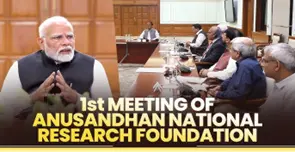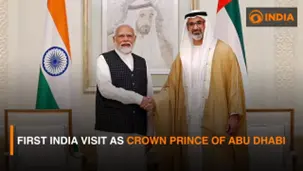Friday, 13th September 2024
2nd International Conference on Green Hydrogen
Why in the news?
- Recently, the Prime Minister Shri. Nerndra Modi envisions India as a global Green Hydrogen hub at 2nd International Conference on Green Hydrogen.
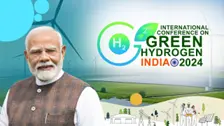
About Green Hydrogen
- Aim:
- National Green Hydrogen Mission launched in 2023, PM outlined India’s goals to make it a global hub for production, utilization and export of Green Hydrogen (GH2).
- Feature:
- It is referred to as Hydrogen produced by electrolysis which breaks down water molecules (H2O) into hydrogen Similarly, oxygen is produced by the use of renewable resources such as solar, wind, water.
- GH2 can also be produced from biomass, Includes biomass gasification Hydrogen .
- Applications of the GH2:
- Fuel Cell Electric Vehicles, Aviation and Marine, Industries (Fertilizer Refineries, Steel, Transport (Road, Rail), Shipping, Power generation.
How India Can Become a Global Hub for Green Hydrogen (GH2):
- Production:
- To achieve a target of 5 Million Metric Tons (MMT) of GH2 production, India needs an estimated investment of $100 billion. Key steps include:
- Funding: Public-Private Partnerships (PPPs) can mobilize private sector capital and expertise for financing large-scale GH2 projects.
- Partnerships: Collaborating with global leaders can facilitate technical expertise and knowledge transfer, essential for scaling up.
- Innovation: Continued investments in Research and Development (R&D) can enhance the efficiency of electrolyser and fuel cell technologies, driving down costs.
- Utilization:
- GH2 can replace fossil fuel-derived feedstocks in industries like petroleum refining, fertilizer production, and steel manufacturing.
- Hydrogen-fueled long-haul transport and marine vessels could help decarbonize the mobility sector.
- Export Potential:
- With a projected global demand of over 100 MMT of GH2 and derivatives like Green Ammonia by 2030, India has the potential to export about 10 MMT of GH2/Green Ammonia annually.
- Challenges:
- High Costs: GH2 production technology remains expensive, hindering large-scale deployment.
- Transportation: Technical and logistical challenges exist in transporting hydrogen over long distances.
- Regulatory Framework: The absence of a comprehensive regulatory framework for GH2 could impede growth and investment in this sector.
- To achieve a target of 5 Million Metric Tons (MMT) of GH2 production, India needs an estimated investment of $100 billion. Key steps include:
|
UPSC Civil Services Examination Previous Year Question (PYQ) Prelims Q:1 Hydrogen fuel cell vehicles produce one of the following as “exhaust” (2010) (a) NH3 (b) CH4 (c) H2O (d) H2O2 Ans: (c) |
Source: PIB
Ayushman Bharat health insurance for senior citizens
Why in the news?
- Recently,The Union Cabinet has cleared the expansion of the Ayushman Bharat Pradhan Mantri Jan Arogya Yojana (AB PM-JAY) to provide health coverage to all senior citizens aged 70 years.
Ayushman Bharat Pradhan Mantri Jan Arogya Yojana (AB-PMJAY):
- About
- Launched in September 2018, the scheme aimed to offer medical coverage of Rs. 5 lakh per family per year for secondary and tertiary care hospitalization to poor and vulnerable families.
- The scheme covers over nearly 40% of the population targeted towards the poorest and the vulnerable.
- Eligibility
- The scheme is targeted to cover 10.74 crore poor, deprived rural families and identified occupational category of urban worker’s families.
- Benefits
- It provides cashless access to health care services for the beneficiary at the point of service, i.e., the hospital.
- It offers Health Benefit Packages which covers surgery, medical and day care treatments, cost of medicines and diagnostics.
- Role of National Health Authority (NHA)
- Designing strategy, building technological infrastructure and
- Implementation of National Digital Health Mission to create a National Digital Health Ecosystem.
- To implement the scheme at the State level, State Health Agencies (SHAs) in the form of a society/trust have been set up by respective States.
- Performance

Ayushman Bharat health insurance for senior citizens
- Extension of the scheme
- The extension will now cover all citizens aged 70 years and above, offering Rs 5 lakh annual coverage per family.
- This expansion is expected to benefit an additional 6 crore elderly people from 4.5 crore families.
- Coverage under new plan:
- Shared top-up coverage - If there are two senior citizens (70 years+) in a family, then the Rs 5 lakh coverage will be shared between them.
- Those benefiting from other public health insurance schemes like CGHS, ECHS, or Ayushman CAPF can either continue with their current schemes or opt for AB PM-JAY.
- Additionally, senior citizens under private health insurance policies or the Employees’ State Insurance Scheme will also be eligible to avail the benefits of AB PM-JAY.
- Benefits
- This expansion is expected to provide substantial relief to a demographic that often struggles with managing disease burdens without a reliable social security net.
- This move is essential as India witnesses a shift towards nuclear family structures, where the financial burden on elderly individuals is more pronounced.
- Although the Ayushman Bharat scheme aimed at universal health coverage, this will be the first age group to receive full coverage.
Source: IE
PM E-DRIVE Scheme
Why in the news?
- Recently the Ministry of Heavy Industries for “PM Electric Drive Revolution in Innovative Vehicle Enhancement (PM E-DRIVE) Scheme” was cleared.

Objectives:
- Accelerate EV Adoption: Aims to speed up the switch to electric vehicles with upfront purchase incentives and charging infrastructure.
- Support Diverse Vehicle Categories: Promotes electric vehicles, including two-wheelers (e-2Ws), three-wheelers (e-3Ws), ambulances, buses, and trucks, to boost electric mobility.
- Enhance Charging Infrastructure: Tackles range concerns by funding new fast chargers.
- Integrate EVs into Healthcare: Allocates funds specifically for deploying electric ambulances, promoting greener healthcare solutions.
Significance:
- Environmental Benefits: expected to significantly reduce air pollution and dependency on fossil fuels.
- Economic Growth and Employment: create substantial employment opportunities in the EV manufacturing sector and associated supply chains.
- Support for Domestic Manufacturing: By implementing a phased manufacturing program (PMP), the domestic EV supply chain is strengthened, supporting the government’s Atma Nirbhar Bharat vision.
- Simplified EV Purchasing Process: The introduction of e-vouchers simplifies the process for consumers to claim subsidies, making electric vehicles more accessible.
Challenges:
- Implementation Coordination: Across various states and union territories may pose challenges, requiring coordination among multiple stakeholders.
- Affordability of EVs: Despite subsidies, maintaining the affordability of electric vehicles for lower-income segments may be difficult, potentially limiting adoption.
- Technological Adaptation: The scheme must remain adaptable to accommodate rapid advancements in EV technology and changing consumer preferences to ensure its long-term effectiveness.
- Infrastructure Availability:While the scheme allocates funds for charging infrastructure, ensuring widespread availability and accessibility of charging stations remains a critical challenge.
Initiatives taken in EV Sector:
- National Electric Mobility Mission Plan (NEMMP) to encourage the adoption of EVS in India.
- Production-Linked Incentive (PLI) scheme for the Auto and Auto Component.
- PLI scheme for manufacturing advanced chemistry cell (ACC) batteries
Source: PIB
4 years of Pradhan Mantri Matsya Sampada Yojna (PMMSY)
Why in the news ?
- Recently, Pradhan Mantri Matsya Sampada Yojana (PMMSY) Completed 4th year of implementation.
About PMMSY:
- Aim: It is launched in 2020 to bring Blue Revolution through sustainable and responsible development of the fisheries sector in India.
- Duration: Tenure FY 2020-21 to FY 2024-25
- Targets: fish production to 22 million metric tons; Reduce post-harvest losses from 20-25% to about 10%; Double export earnings to about Rs. 1 lakh crore etc.
- Investment: Total- Rs. 20,050 Cr. Central Sector Scheme- 9407 Cr.,Center sponsored 18330Cr., Center sector Component– 1720 Cr., State Sector scheme- 4880 Cr. Private beneficiaries - 5763 Cr.
Objectives of PMMSY:
- Harnessing of fisheries potential
- Modernizing value chain, post-harvest management and quality improvement
- Enhancing fish production and productivity
- Build robust fisheries management and regulatory framework
- Doubling fishers and fish farmers’ incomes and generation of employment.
Achievements of PMMSY from 2020-21 to 2024-25:
- Contribution of the fisheries sector: The fisheries sector to GVA in agriculture is estimated to increase from 7.28% in 2018-19 to around 9% in 2024-25.
- Export earnings: Double from Rs. 46,589 crore in 2018-19. 100,000 crore by 2024-25.
- Postharvest losses: Decrease from 20-25% to about 10%.
- Employment: The program is expected to create 1.7 million new jobs, with a focus on employing 75,000 women.
- Fish Store: 6,733 fish stands and fish stands have been approved.
- Water Health Management: 17 diagnostic and laboratory test sites have been approved for quality.
- Ornamental fishing: 2,153 ornamental fishing permits issued.
- Marine weed farms: 46,095 tanks and 66,330 monoline tube connections have been approved.
Changes include fishing:
- National Fisheries Development Project Portal was constructed under Prime Minister Fishermen Prosperity Sah Scheme, under Sub-Scheme PMMSY.
- It will be a central hub for angling member registration, information, services and fishing-related support.
- Pearl farming, ornamental fishing and Seaweed planting to encourage innovation in these scenic areas.
- Pilot project on drone technology for fish transport by Central Institute of Inland Fisheries and Research for Drone Search’; Authority to regulate inland fisheries.
- Establishment of Mandapam Regional Center of Central Marine Fisheries Research Institute as a center of excellence for marine algae promotion Agriculture and research.
- Availability of 3 nursery areas For Hyderabad, Mumbai and Kochi promoting at least 100 fishing start-ups, cooperatives.
- Previous priorities included development in the five Aqua Aqua parks in Assam, Chhattisgarh, Madhya Pradesh, Tripura and Nagaland and Nagaland; Two installations of Global fish markets in Arunachal Pradesh and Assam; etc.
Source: PIB
National Florence Nightingale Award
Why in the news ?
- Recently, The President of India, Smt. Droupadi Murmu presented the National Florence Nightingale Awards for the year 2024 to the nursing professionals.
About the National Florence Nightingale Award:
- It was established in 1973 by the Ministry of Health and Family Welfare, Government of India.
- The award is given to outstanding nursing staff working in Central, State/UTs and voluntary organizations.
- It was given as a mark that nurses and nursing staff provide quality services to the community.
- A nurse who works permanently in a clinical or community, educational or administrative setting is eligible to receive a national award.
- Each award consists of a certificate of professionalism, a cash prize of Rs.1,00,000/- and a trophy.
Who is Florence Nightingale?
- Florence Nightingale was an English social reformer, mathematician, and founder of modern nursing.
- Nightingale made a name for herself during the Crimean War as a nurse officer and trainer, organizing the care of wounded soldiers in Constantinople
- Her efforts to formalize nursing education established the first science-based nursing school- the Nightingale School of Nursing at St Thomas' Hospital in London
Source: PIB
Trade Connect e-Platform
Why in the news ?
- Recently, the Union Minister for Commerce and Industry Shri Piyush Goyal launched the Trade Connect e-platform.
About the Trade Connect e-Platform:
- It is a new digital initiative aimed at transforming the international business environment for Indian exporters, especially MSMEs (medium, small and medium enterprises).
- It will engage with various stakeholders including Indian exporters, MSMEs, Indian missions abroad, Export Promotion Council and other partner government agencies.
- The platform will provide information on trade trends in different parts of the world, benefits available due to India’s Free Trade Agreements (FTAs), and other news and information related to international trade
- The platform was developed with key partners including the Ministry of MSMEs, Exim Bank, Department of Financial Services (DFS), and Ministry of External Affairs (MEA).
Significance:
- This initiative is in line with the government’s broader vision of promoting Digital India, promoting greater transparency and empowering businesses by providing easy access to critical business data
- This will reduce the costs, lead times and complexities associated with global business, ultimately enabling Indian businesses to succeed in international markets.
Source: PIB
Southern Birdwing butterfly
Why in the news ?
- Recently, India’s second largest Birdwing butterfly has been found on the satellite campus of The American College in the Madurai district of Tamil Nadu.

About Southern Birdwing butterfly:
- About: It is also called the ‘Sahyadri Birdwing’ and it is India’s second largest butterfly species.
- Distribution: It is a large and striking butterfly species found in South Asia, majorly in the Western Ghats.
- Physical Characteristics :
- It is exceptionally large in size, with wings that exceed the dimensions of smaller birds. This notable wingspan is the reason behind its name, “birdwing.“
- Males typically have black wings with greenish-blue markings, while females have a more extensive pattern with cream-coloured markings.
- State Butterfly : It is the state butterfly of Karnataka.
- Conservation status IUCN: Least concern
Key points about Western Ghats:
- It is a mountain range that covers an area of 160,000 sq km in a stretch of 1,600 Km parallel to the western coast of the Indian peninsula.
- It traverses through the states of Gujarat, Maharashtra, Goa, Karnataka, Kerala and Tamil Nadu.
- It is a UNESCO World Heritage Site And is one of the 36 biodiversity hotspots in the world.
- These Ghats are home to high mountain forests, which moderate the tropical climate of the region and present one of the best examples of the monsoon system on the planet.
Source: TH
PM-eBus Sewa- PSM Scheme
Why in the news ?
- Recently, the Union Cabinet approved the PM-eBus Sewa-Payment Security Mechanism (PSM) scheme for procurement and operation of e-buses by Public Transport Authorities.
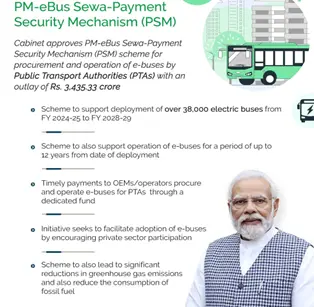
About the PM-eBus Sewa- PSM Scheme:
- It will support deployment of more than 38,000 electric buses (e-Buses) from FY 2024-25 to FY 2028-29 with an outlay of over Rs.3,435 crore.
- It will support the operation of e-buses for a period of up to 12 years .
- At present, the majority of buses operated by Public Transport Authorities (PTAs) run on diesel/CNG, causing adverse environmental impact.
- e-buses are environmentally friendly, cost-effective and their high up-front costs have been a barrier to adoption.
- The government’s vision of promoting a self-reliant India by promoting Made in India e-buses and reducing its dependence on fossil fuels
- The scheme is open to all PTAs in those states and UTs that opt to participate.
- To address the default problem of the PTA, the system includes a Payment Protection Mechanism (PSM) administered by its implementing company Convergence Energy Services Limited (CESL).
- CESL ensures timely payment to OEMs/contractors and, in case of default, payment from the scheme fund, later recovery from the concerned PTA, State, or Union Territory.
Source: PIB
Making India a Start-Up Nation
Context:
- India has the third largest startup ecosystem in the world, with over 140,000 registered startups and a new unicorn appearing every 20 days.
- To sustain this growth and achieve a developed India by 2047, effective integration of education, employment and entrepreneurship is essential.
- If 5% of Indian graduates become entrepreneurs, 50,000 new jobs will be created every year, creating millions of jobs.
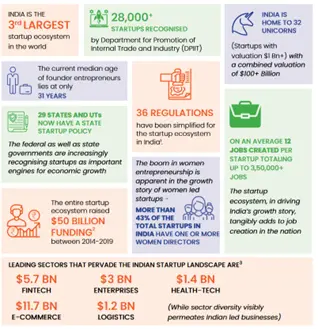
Current state of India’s startup sector:
- Large ecosystem and growth:
- India ranks third globally with over 1.4 million startups registered under the Department of Industry and Domestic Trade Promotion (DPIIT) India's ecosystem.
- In the last 7-8 years, a unicorn has appeared every 20 days, indicating the region’s capacity for entrepreneurship and growth.
- Job creation:
- The start-up has directly created over 1.55 lakh jobs.
- By 2023, 3.9 million jobs will be created, representing an annual growth rate of 46.6% and an increase of 217.3% over five years.
- Economic Contribution:
- Startups, and companies, contributed $140 billion to India’s GDP in FY23, accounting for nearly 4% of total GDP.
How India’s startup scene is evolving:
- Digital Infrastructure Revolution:
- With over ₹20 lakh crore in transaction value by August 2024, Unified Payment Interface (UPI) has played a major role in this growth.
- Coupled with the lowest data charges in the world (₹6.7 per GB by 2023), startups now have easy access to more customers.
- Supportive government policies:
- As of June 30, 2024, 1,40,803 start-ups have been accredited, providing tax benefits and compliance accreditations.
- ₹7,980 crore has been invested in 99 Alternative Investment Funds (AIFs) by December 2022 under the Fund of Funds Scheme (FFS).
- Growing talent pool:
- India’s young population (65% under 35) and 1.5 million engineering graduates form a huge talent reservoir for start-ups every year.
- Maturity Financing Ecosystem:
- In H1 2024, Indian startups raised $4.1 billion, up 4% from H2 2023. Growth in the domestic economy and interest from global investors has led to a range of funding streams
- Industry-specific opportunities:
- The aerospace technology sector saw an investment of US$124.7 million by 2023.
- The successful launch of Skyroute Aerospace’s Vikram-S rocket by 2022 has opened the door for private players in space
- Growing domestic market:
- India’s expanding middle class, which is expected to add 140 million households by 2030, presents huge opportunities for start-ups Estimated to be worth around US$100 million by 2025. 188 billion dollars
- Corporate-Startup Partnerships:
- Companies like Reliance Industries and Tata Digital are investing in start-ups, as seen in Tata’s acquisition of 1mg, which highlights the potential for strategic partnerships.
Compressed Roadblocks to Indian Startup Growth:
- Regulatory Hurdles: Complex regulations, like the debate over Ola and Uber under the Motor Vehicles Act and compliance burdens from the Digital Personal Data Protection Act, 2024, create operational challenges for startups.
- Talent Retention: Despite many graduates, 60% of Indian tech professionals are open to relocating abroad, leading to competition with MNCs and overseas opportunities, affecting startups' talent retention.
- Market Saturation and Competition: Overcrowded sectors, such as edtech, face intense competition and reduced margins, with firms like BYJU's and Unacademy cutting jobs post-pandemic.
- Infrastructure Gaps & Uneven Funding: Rural internet penetration is only 37%, limiting market potential. Women-led startups also face a significant funding gap, despite urban penetration of 71%.
- Scaling Issues: 90% of startups fail within five years due to challenges in scaling operations and expanding to new markets.
- Lack of Deep Tech Innovation: India spends just 0.7% of GDP on R&D, lagging in deep tech despite government incentives like the USD 10 billion semiconductor scheme.
- Exit Challenges: The number of IPOs dropped in 2023, with ₹41,095 crore raised, marking a 30% decline from the previous year, limiting viable investor exit options.
Measures to Enhance the Startup Sector in India:
- Decentralized Startup Hubs: Develop tier-2 and tier-3 cities into startup hubs with targeted infrastructure and incentives, adopting a hub-and-spoke model similar to Mohali’s successful ecosystem expansion.
- Enhanced Tax Incentives: Extend tax benefits for startups from three to five years and introduce additional breaks for deep-tech startups, inspired by Israel’s tax incentives for tech companies.
- Robust IP Protection Framework: Streamline patent processes and introduce fast-track examinations for startups, with an IP awareness program modeled on Japan’s accelerated patent examination system.
- Government Procurement Boost: Mandate a percentage of government procurement from startups, similar to the US’s 23% federal contracts for small businesses, opening a significant market for startups.
- Sector-Specific Incubation Centers: Establish incubation centers focused on sectors like spacetech, biotech, and cleantech, modeled after the successful T-Hub in Hyderabad.
- Startup-Academia Collaboration Platform: Create a national platform to facilitate collaborations between startups and academic institutions, aiming for 1,000 collaborations annually by 2025.
- Enhanced Funding Access: Expand the Fund of Funds for Startups (FFS), create sector-specific funds, and introduce a credit guarantee scheme for startup loans, inspired by the UK’s Enterprise Finance Guarantee.
- Digital Infrastructure Push: Accelerate BharatNet implementation for high-speed internet connectivity in villages by 2025, inspired by Estonia’s e-Residency program to foster a digital business environment.
Conclusion:
To sustain and enhance India's startup sector, addressing regulatory challenges, promoting collaboration between academia and industry, and ensuring equitable access to funding and infrastructure are crucial. By integrating these elements, India can harness its entrepreneurial potential and move towards becoming a developed nation by 2047
|
UPSC Previous Year Question (PYQ) Prelims Q:1 What does venture capital mean? (2014)
Ans: (b) |
Source: IE
Share the article
Edukemy’s Current Affairs Quiz is published with multiple choice questions for UPSC exams
MCQ
Get Latest Updates on Offers, Event dates, and free Mentorship sessions.

Get in touch with our Expert Academic Counsellors 👋
FAQs
UPSC Daily Current Affairs focuses on learning current events on a daily basis. An aspirant needs to study regular and updated information about current events, news, and relevant topics that are important for UPSC aspirants. It covers national and international affairs, government policies, socio-economic issues, science and technology advancements, and more.
UPSC Daily Current Affairs provides aspirants with a concise and comprehensive overview of the latest happenings and developments across various fields. It helps aspirants stay updated with current affairs and provides them with valuable insights and analysis, which are essential for answering questions in the UPSC examinations. It enhances their knowledge, analytical skills, and ability to connect current affairs with the UPSC syllabus.
UPSC Daily Current Affairs covers a wide range of topics, including politics, economics, science and technology, environment, social issues, governance, international relations, and more. It offers news summaries, in-depth analyses, editorials, opinion pieces, and relevant study materials. It also provides practice questions and quizzes to help aspirants test their understanding of current affairs.
Edukemy's UPSC Daily Current Affairs can be accessed through:
- UPSC Daily Current Affairs can be accessed through Current Affairs tab at the top of the Main Page of Edukemy.
- Edukemy Mobile app: The Daily Current Affairs can also be access through Edukemy Mobile App.
- Social media: Follow Edukemy’s official social media accounts or pages that provide UPSC Daily Current Affairs updates, including Facebook, Twitter, or Telegram channels.


